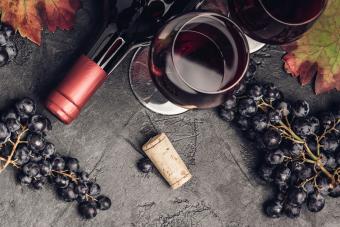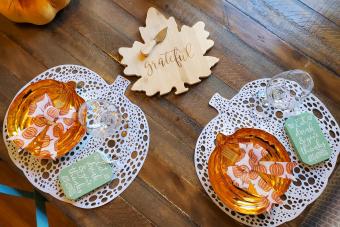
Dappling in red wine for the first time? While it can be a little overwhelming between all the varieties and blends, the vast array of wines out there also means there is definitely something for every palate. Get to know red wine, learn which reds are best for beginners, and let your taste buds guide you from there.
Red Wine Guide
It's best to start with approachable, fruit-forward red wines that are easy to drink. Save the austere characters for down the road when you're more likely to appreciate them.
Young, Fresh Reds
Sommelier, Michael Wray, notes that "Youthful reds will be more fresh fruit flavors, while a more aged wine will have baked and aged fruit flavors." For example, Wray finds that beginning wine tasters tend to be more attracted to fresher, brighter plum notes that are more common in younger wines rather than dried or baked plum flavors which are more typical in aged wines.
Low Tannins
In general, steering clear of overtly tannic wines from the get-go is best. Tannins are imparted by the red grape skins and are present in various levels in all red wine, though some varieties are especially tannic. That drying sensation in your mouth post sip are the tannins at work. Often times, highly tannic wines will take some warming up to and many people find them to complement food well, but be slightly less enjoyable on their own.
Blends
Don't overlook blends! Just like the cello and viola round out the violins in a quartet, a few different varieties playing together in a bottle can complement each other quite well. From classic blends like Bordeaux, to more unconventional, kitchen sink blends, there are only about 1.2 million options, so it's best to get a recommendation from your local bottle shop owner unless you know exactly what you are looking for.
Good Red Wines for Beginners
There are many ways to approach red wine. Starting with single varieties is an easy way to narrow in on aromas and flavors you particularly enjoy as well as learn what you're not a fan of. Wray's words of wisdom, "Start light. Consider lighter bodied wines as a gateway to more fuller bodied wines. These wines are full of fruit flavor and often lower in tannins with fewer bitter flavors that can sometimes turn off the beginning wine enthusiast." A great way to taste more wines in a sitting is to opt for a tasting flight at a winery or host a dinner party with numerous styles of wine. The more you taste, the more you will hone in on what you like.
Grenache
Grenache, or garnacha, is a red grape bursting with bright, fruit flavors of strawberry, red plum, and red cherry. Medium in body, it can have hints of liquorice and white pepper, which balance out the fruity nature. It doesn't have ripping acidity, which makes it easy and playful to drink. Wray says, "The natural lower acid of grenache/garnacha makes for a more approachable match to foods with acidic sauces, such as BBQ sauce".
Gamay
There really couldn't be a better intro into red wine than a good glass of gamay. A light-hearted, juicy red with a real punch of cherry, black currant, and raspberry, this is a true glou glou (glug-glug) wine. Vibrant and young with delicate floral aromas of violet to match the poppy fruit flavors, this wine will no doubt turn you into a red wine drinker.
Zinfandel
Zinfandel is smooth talker, full of brambly hedge fruit flavors like raspberry and blackberry laced with hints of baking spice. Full-bodied, with silky tannins, zins go down pretty easy. Look for a California zinfandel or a primativo from southern Italy. The warm climates grow grapes that make lush, jammy wines.
Merlot
Merlot has intense yet rounded flavors of dark plum, black cherry, and chocolate. With its full body, soft tannins, and smooth finish, a glass of merlot is reminiscent of being wrapped in a weighted blanket for the evening.
St. Laurent
This Austrian varietal is perfect for finding your way into red wines. It's medium-bodied with a fruit explosion of blueberry, raspberry, and cherry. This juicy number is extra good with a slight chill. Great on its own or paired with just about anything, if there was a grape to convert you, it might be this one.
Malbec
This is a full-blown red without the grippy tannins. Rich and abundant with raspberry, black cherry, red plum, and cocoa, it is a sensual, bold wine that will ease you into the world of powerful reds. Commonly matured in oak, you may find toasty notes of vanilla and sweet tobacco accompanying the fruit.
Sangiovese
An Italian favorite, a glass of sangiovese with a pizza will have you imagining the rolling hills of central Italy in no time. With notes of tart cherry, strawberry, garden tomato, clay, and savory herbs of oregano and thyme, it's easy to love. Sangiovese has a little more aggressive tannins than some other wines, so pair this one with a plate of pasta or slice of pizza and you'll warm right up to it.

Cabernet Sauvignon
The beloved cab sauv is a kind of an American favorite. The most widely grown grape in the world makes full-bodied wines that hold their own at the dinner table. Rich with notes of black currant, blackberry, graphite and white pepper, this is an intro into heavy-hitter reds. Best to accompany your exploration into cabernet sauvignon with proper meal.
Pinot Noir
The best pinot noir is grown in cool climates in France, New Zealand, and Oregon. It's a great wine to reach for when wanting something light in body. Typically, it has notes of cherry, raspberry, and mushroom with subtle notes of hibiscus and early summer rose petal. While higher in acidity, the tannins in pinot noir never get too aggressive.
Dolcetto
Another Italian variety, this time from the north, dolcetto is a black-fruit forward wine with notes of black pepper and cocoa and subtle floral aromas of spring violet. Bright with mild tannins, dolcetto is a structured wine without taking it too far. It's a great red to sip while cooking dinner, seamlessly transitioning to the table.
When It Comes to Drinking Red Wine
While you can dial in the stemware, serving temp, and pairings, don't stress over it. A glass of wine can be a simple pleasure, enjoyed any way you wish.
Glassware
New to wine and don't have wine glasses? No worries. Any vessel will do. But if you find yourself getting into reds, you might want to invest in a pair of wine glasses. The shape of the glass allows you to give it a swirl, pushing oxygen into the wine and encouraging it to emit all of its delicate aromas, funneling them directly to your nose.
Serving Temperature
Most red wines should be served between 54-64°F (12-18°C), which is below room temperature, so make sure to cool your wine down prior to pouring. You can throw it in the refrigerator for a short while or find a cooler place in your house to store it. In general, lighter-bodied wines should be on the low end of that temperature range, while fuller-bodied wines are more expressive when enjoyed at the higher end of the spectrum. Some reds are meant to be enjoyed fully chilled, like whites. At the end of the day, these are all guidelines; if you find yourself wanting to drink a wine a certain way, go for it!
Food & Wine Pairings
Food and wine. Is there anything better? There is a whole technical puzzle based on how the palate perceives acidity, sweetness, tannins, saltiness, and body which guides formal pairings. Without going down a rabbit hole, you can use your common sense and personal preferences to decide what to eat with your wine. You may also find that you enjoy certain reds all on their own.
Red Wines for Beginners Expand Your Palate
When trying new wines, take note of what you like (and what you don't). The more you can articulate what you enjoy, the better chance a sommelier will effectively guide you to new wines you may fall for. Branch out and experience the full spectrum of grapes, regions, winemaking styles, and producers. The diversity in flavors offers a unique window to a place and time.







